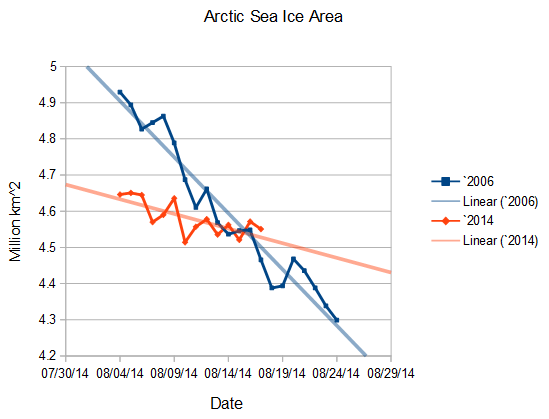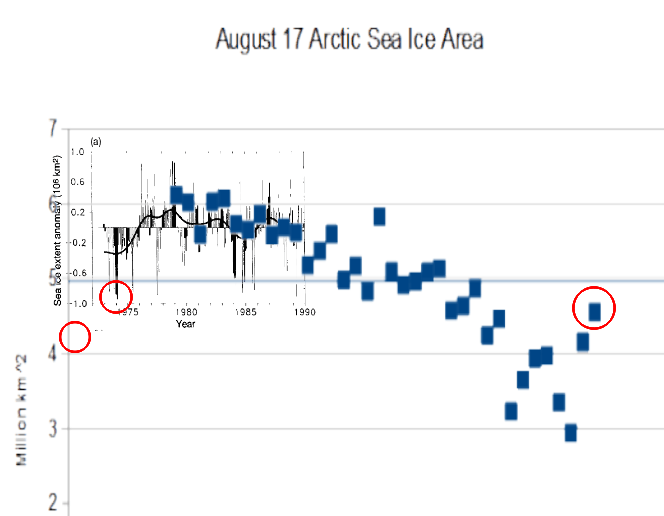As bad as this year has been for Arctic alarmists, their pain is just beginning. Melt has been extremely slow in August, in fact area has not changed for about a week, and is now larger than 2006
The ice has been getting compacted close to the pole, where it is too cold to melt. (Compaction reduces extent, but has little effect on area.) The high pressure system which has been compacting the ice is breaking down, and in a week or so, the open water close to the pole in the Laptev Sea will begin to freeze, likely leading to an early minimum.
As I mentioned earlier, ice area is the highest in ten years, and may be higher than 1971.
Nobel Laureate Al Gore says there is a 75% chance the Arctic will be ice-free this summer.




There is a 100% chance, that Al Gore will be wrong, and that he does not know what he is talking about. It is complete fiction!
ABC, Aust. Radio National, the Science Show, 16 August, 2014.
http://www.abc.net.au/radionational/programs/scienceshow/the-role-of-sea-ice-in-arctic-climate/5671036#transcript
Presenter Robyn Williams, science guru, is famous for this doomsday prediction:
http://blogs.news.com.au/heraldsun/andrewbolt/index.php/heraldsun/comments/100_metres_williams_is_already_four_metres_down_in_four_years
2015 is next, “although I think that’s an extreme prediction,” says Grae Worster.
Robyn Williams: And where do you go to do your studies? Do you actually go into the field, in the Arctic, or what?
Grae Worster: I mostly push a pen in the maths department. We do do experiments in the basement of the mathematic department, freezing saltwater and looking to see how it behaves.
the temp graph showing what’s happening above 80*N, says that it’s already below 32*F up there…
that’s pretty much it for the melt season, i would think, unless the temp spikes unexpectedly.
Could be a little bit more melting around the edges… where it is a bit warmer. Looks like it will be the 11th lowest Arctic summer ice since satellite records began!!!!
Then there is a chance the CAGW industry will be saved by Bárðarbunga (link: http://en.wikipedia.org/wiki/B%C3%A1r%C3%B0arbunga ) You can bet the excuses machine will be in high gear if that one goes off.
http://m.dailykos.com/story/2014/08/17/1322378/-Just-To-Let-You-All-Know
The volcano ate all our heat. Honest.
Very interesting, thanks for the link.
I’m not expecting any large eruption until at least the mid 2020’s, based strictly on the frequency of these phenomena and a possible relationship with very large EQs, M8.8 or more.
It’d seem from historic records that periods of relatively high frequency of large EQs, as have been happening in the first 14 years of this century, would preclude any large (VEI6+) volcanic eruption. OTOH, periods of low or lowering intensity of solar cycles seem to be associated with large eruptions too, let’s see.
A powerful VEI6+ in the present scenario would greatly accelerate the cooling for a couple of years, like a powerful La Nina.
From the link,
“… The quantity, scale, and depth of [the EQs of the swarm] have never been observed there before by modern equipment on this volcano [Bárðarbunga], and are similar to what was observed in nearby Grímsvötn shortly before it went off … “
I believe the Grímsvötn eruption of May 2011 is, so far, the largest of this century.
Two summers ago a summer gale in August shattered the ice, and melted a lot of it. I think that melting cooled the water, and the storms churning (that brought warmer water up) broke down the stratification, (that has warmer, salty water below colder fresher water.) Because the resultant ocean was colder overall, the storm we had last August shattered the ice, but the ice didn’t melt. As I recall, this site had a good satellite picture of how shattered the ice was back then.
It might be a good comparison, to find that picture of shattered ice from last summer and put it next to a picture from this summer. It would demonstrate how much more compact and solid the ice has become.
I think you must be confusing this site with Snow White’s Caleb. Here’s the answer to the first part of your request:
https://twitter.com/jim_hunt/statuses/501630621211705344
I’ll leave the second part as an exercise for any interested readers out there.
“Nobel Laureate Al Gore says there is a 75% chance the Arctic will be ice-free this summer.”
No, no. This year. And we still have more than four months to go — Al.
Good analysis. What the headlines never tell you is that the metric of Arctic sea ice is affected by many factors, which your easy to read analysis brings into focus.
The press does not talk about it because it does not bleed. And does not fit their narrative.
No, I didn’t visit your site, and did see the picture posted by our host at this site. I actually stole it and posted it on my site last August, giving credit where credit is due, of course.
Some thought the open water would absorb sunshine and the water would warm, but the 90-day-period the sun is highest ends August 6, and the possible warming decreases as the sun gets lower. In fact glassy water does a better job reflecting sunlight, once the sun gets down on the horizon, than old, gray ice does. (And that doesn’t include the heat open water loses to the air.)
The current visible satellite picture of the Pole is at http://www.arctic.io/explorer/ , and allows one to zoom in. It is cloudy at the Pole right now, but the clear skies northeast of Greenland allows one to see how packed up the ice is in that area. Towards the Pole it is less pulverized, and never bothered to break up much this summer.
The failure of the ice to break up and spread out this year has made a shambles of my extent forecast. I was wrong, and admit it.
See? I did it. I admitted a mistake and I’m still alive. Pity so many Climate Scientists seem unable to do the same. However I suppose they fear their funding will get cut if they admit errors.
You don’t have to go back far on NASA WorldView to get a glimpse of the structure of the sea ice between the Pole and Ellesmere: http://1.usa.gov/1qmqmGl
Steven, I do not understand your parenthetical statement: “Compaction reduces extent, but has little effect on area.” Can you elaborate a little?
If you push the ice cubes in your drink together, the extent decreases, but the area of ice doesn’t change.
I also wonder about the difference between “extent” and “area”.
At a guess, since someone mentioned “shattered” ice — “extent” includes shattered ice but “area” refers to solid ice?
I believe the “extent” is an average over a region where the amount of ice is above some lower percent limit, like 15% or 30% of the total area, while the “ice area” is a more direct measurement of the total area covered exclusively by ice.